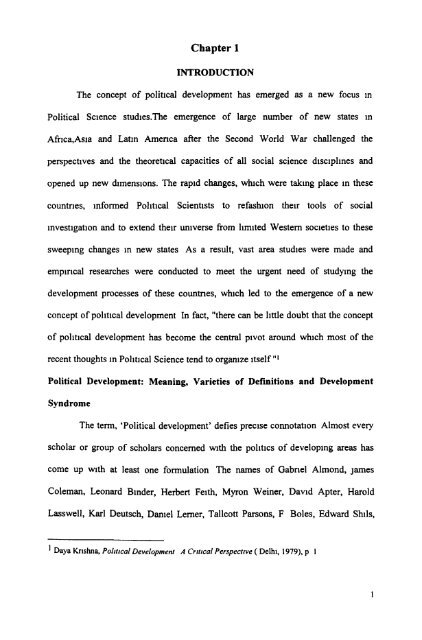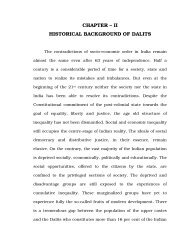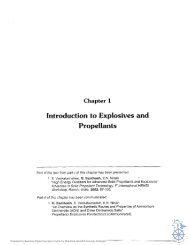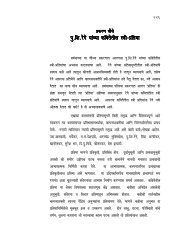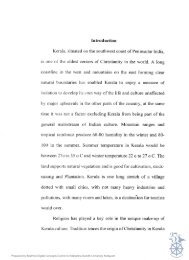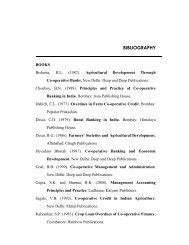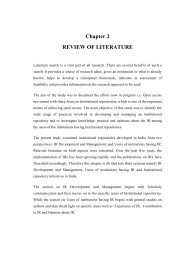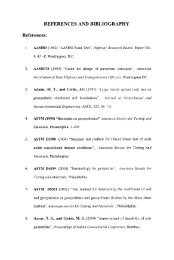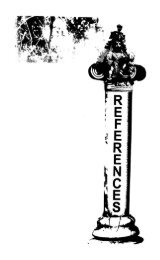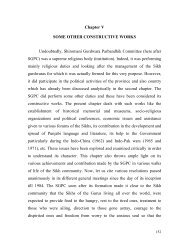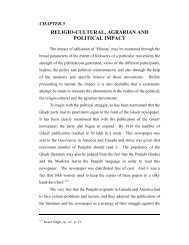08_chapter 1.pdf
08_chapter 1.pdf
08_chapter 1.pdf
You also want an ePaper? Increase the reach of your titles
YUMPU automatically turns print PDFs into web optimized ePapers that Google loves.
Chapter 1<br />
INTRODUCTION<br />
The concept of political development has emerged as a new focus in<br />
Political Science studies.The emergence of large number of new states in<br />
Afnca,As~a and Latin Amerlca after the Second World War challenged the<br />
perspectives and the theoret~cal capacities of all social science dlscipl~nes and<br />
opened up new dimens~ons. The rap~d changes, which were taking place In these<br />
countries, Informed Pol~t~cal Scientists to refash~on their tools of social<br />
investigation and to extend their universe from lim~ted Western socletles to these<br />
sweeplng changes in new states As a result, vast area studies were made and<br />
empirical researches were conducted to meet the urgent need of study~ng the<br />
development processes of these countries, whch led to the emergence of a new<br />
concept of polltical development In fact, "there can be little doubt that the concept<br />
of pol~tlcal development has become the central plvot around which most of the<br />
recent thoughts in Polltical Science tend to organlze itself "1<br />
Political Development: Meaning, Varieties of Definitions and Development<br />
Syndrome<br />
The term, 'Political development' defies precise connotation Almost every<br />
scholar or group of scholars concerned mth the pol~tics of develop~ng areas has<br />
come up with at least one formulation The names of Gabnel Almond, James<br />
Coleman, Leonard Blnder, Herbert Fe~th, Myron Weiner, Dav~d Apter, Harold<br />
Lasswell, Karl Deutsch, Daniel Lemer, Tallcott Parsons, F Boles, Edward Shls,<br />
I Daya Krshna, Polrrrcol Developmenr A Cr!r!col Penprcove ( Delhl, 1979), p I
Joseph La Palombara, C E Ward, A F K Organsk~k, Sydney Verba. C E Black,<br />
C E Welch, F W Rlggs, Samuel P Huntington, Alford D~amant, Dankwan A<br />
Rustow, Robert Holt, J C. Turner, S.N. E~senstadt, S K Arora and a host of other<br />
soc~al theorists may be referred to in th~s connection Even to itemize them all<br />
would be a tlresome and not a particularly useful task<br />
However, in h~s Aspects of Polir~cal Development, Luclan W Pye has<br />
completed a fa~rly comprehensive llstlng of ten meanings, whlch have been<br />
attr~buted to the concept of pol~t~cal development2 Pye has summarlzed diverse<br />
defin~t~ons In to ten polnts and after commenting upon them, he comes out w~th<br />
certaln conclus~ons<br />
Pye beglns w~th those scholars such as Paul A Baran, Norman S<br />
Buchanan, Howard S Ellls, and Barbara Ward, who belleve that political and soclal<br />
condlt~ons play a crucial role In rmpedlng or fac~l~tat~ng the economlc growth But<br />
accordrng to Pye, rh~s vlew does not focus on a common set of theoretical<br />
cons~derat~ons Bes~des, economy change far more slowly than pol~tlcal<br />
arrangements, and In most of the under developed countnes people, clearly are<br />
concerned about and anxlous to facll~tate polit~cal development qulte Independent<br />
of ~ ts effects on the rate of economic growth 3<br />
Pye then comments about those soc~al sclentlsts such as W W Rostow, etc.,<br />
_who try to ~dent~fy the process of polltical development w~th the pace of<br />
lndustr~allzat~on But Pye rejects it on the ground that ~t Ignores the role of several<br />
Luoan W Pyc, Aspecrs o/Pol~rtcal Developmenl( New Dclh1.1972). lnd~an cdn, pp 3 1-48<br />
3 Ibld, pp 33-34
other factors l~ke forces that threaten the hold of the vested Interests, an<br />
apprecratlon of the values of orderly legal and administrative procedures, and an<br />
acknowledgment of polltics as a means and not an end m itself4<br />
Various soclal scientists l~ke James Coleman, Karl Deutsch, S M L~pset<br />
ddentify pol~t~cal development w~th pol~t~cal modem~zat~on and assume that<br />
advanced and modem countries are the pace setters of political development But<br />
Pye however feels that it IS against the vlew of cultural relatlvlsm, which questions<br />
the propriety of ~dentifylng industr~al-, i e , western practices as the universal<br />
standards for all polit~cal systems 5<br />
Some social sclentlsts such as K.H.S~lvert, Edward Shlls, McCord, etc , are<br />
mf the oplnlon that polltical development means the organization of polltical llfe<br />
and performance of political funct~ons In accordance with the standard of a nation<br />
state Thls vlew ~dent~fies pol~t~cal development with nationalom But Pye rejects<br />
th~s vlew too on the ground that nationalrsm 1s merely a necessary condlt~on of<br />
polltical development, ~t is not a suffic~ent condltlon.6<br />
Scholars l~ke Max Weber, Talcott Parsons, A M Henderson, and Joseph La<br />
Palombara, etc, emphasize on the need of organlzatlon bulldlng or a need of<br />
effectlve legal and adm~nistrative order for polit~cal development Pye, however<br />
feels that thls approach too ignores vanous factors such as the problem of
crtlzenshlp trainlng and popular partlclpatlon both of whlch are clearly aspects of<br />
pollt~cal development<br />
Soclal theorists l~ke S N. Elsenstadt stress 4;; the role of a pol~t~cally<br />
awakened cltlzetuy and the behavlour of the people m the d~rect~on of an expanded<br />
popular partlclpatlon Thls view too IS rejected by Luclan W Pye, who thlnks that<br />
such vlew "is fraught w~th the danger of either stenle emot~onal~sm or compt~ng<br />
demagoguery " 8<br />
Pye 1s also cr~tlcal of scholars l~ke Joseph La Palombara who assume that<br />
qollt~cal development 1s synonymous w~th the establlshment of democrat~c<br />
lnst~tutlons and practices as, Pye feels that thls vlew "can be seen as effort to push<br />
upon others Amerlcan or at least Western values"<br />
Wnters ltke F W Riggs and Karl Deutsch assert tkat any form of economic<br />
or soc~al advancement does generally depend upon an environment In whlch<br />
uncertainty has been reduced, and plannlng based on reasonably safe predlct~ons 1s<br />
posslble Pye rejects thls vlew also because thrs vlew, according to hm does not<br />
answer that how much order 1s necessary and desirable and for what purpose change<br />
should be dlrected Besldes. coupllng of stab~llty and change 1s not something that<br />
can occur In the dreams of far better classes of soclety than most under developed<br />
masses and mmntenance of order however desirably stands second to gefllng thlngs<br />
done and thus development calls for a somewhat more posluve v1ew.10
Some scholars like James Coleman, Gabnel Almond, and Talcott Parsons<br />
take the vlew that political development can be evaluated In terns of the level or<br />
degree of absolute power, whlch the system is able to mobll~ze Pye crltlclzes th~s<br />
approach on the ground that th~s v~ew Ignores the case of development where the<br />
moblllzatlon of power 1s del~berately kept llm~ted "I1<br />
Pye, however, agree w~th soclal scientists such as Mill~kan ,Blackmer and<br />
Danlel Lerner, etc , who regard ~t worthless to try to lsolate too completely polltical<br />
development from other forms of development They say sustained pol~tlcal<br />
development can take place only w~thin the context of multi-dlmenslonal process of<br />
soclal change. Pye appreciates this vlew 12<br />
In addltlon, there are also other lnterpretatlons of pollt~cal development. For<br />
example, James Coleman, Norbert Wemer, etc., belleve that development means a<br />
sense of natlonal selfrespect and dignity in international affairs 13<br />
In a noble effort at synthesis d~verse vlews on pol~tical development, Pye<br />
attempts to summanze the most prevalent common themes on pol~tlcal<br />
development as lnvolv~ng movement towards, [i] increasing equality- mass<br />
partlcrpatlon In polltlcal activities, untversal~stlc nature of law, the recruitment to<br />
pollt~cal office reflect~ng ach~evement and standards of performance [ill increasing<br />
capaclty - capaclty of a polltlcal system through wh~ch ~t can produce "output" and<br />
the extent to whlch ~t can affect the rest of the soclety and economy. [III] lncreaslng<br />
'1 lbld<br />
I2 lbld<br />
I3 Ib~d, pp45-48
differentiation it IS, not fragmentation and isolat~on of the d~fferent parts of the<br />
polit~cal system, but speclallzation based on ultlmate sense of integration '4<br />
Among various components of polltical development, equallty is related to<br />
pol~tlcal culture, capacity 1s related to the performance of the authontative structure<br />
of Government, and differentiation lndlcates towards performance of the non-<br />
author~tatlve stuctures and the general political process in the society, in the last<br />
analys~s, the problem of political development revolves around the relat~onships<br />
between the polit~cal culture, the authontative suuctures, and the general pol~trcal<br />
process<br />
Political Development : A Concept of Continuous Debate<br />
Though L W Pye has made an appreciable effort to summarize prevalent<br />
notions of politlcal development and to present a comprehensive defin~tion covenng<br />
maln themes of them, yet the difference of oplnlon on the concept has not slnked<br />
and the "quest of political development" ~n John Montgomery's phrase has<br />
necessarily led Political Scientists to provide d~fferent view's on this concept<br />
One such d~fference can be noticed on the relationship between politlcal<br />
development and modermzation The major tendency was to think of political<br />
development as v~rtually identical \nth politlcal modernization The pnncrpal<br />
dissent from thls point of view came from Samuel P Huntington in 1965 He argued<br />
that "though the process of polit~cal development is affected by the process of<br />
modernization, it is Independent of modemizat~on process He defined this term as<br />
the ~nst~tutional~zat~on of political organlzabon and procedures He observed, "Thls
concept liberates development from modernization It can be appl~ed to the analys~s<br />
of polltical system of any sort ,not just modem ones. Huntington also forcefully<br />
challenged the dependence of polltlcal developments study on sociology, and<br />
espec~ally on structural funct~onal approach, popularized by Almond and h~s<br />
followers It IS stated that structural funct~onal approach is under serious crltlclsm<br />
even withln Sociology because fo its insensitiveness to and lim~ted usefulness In the<br />
study of change '5<br />
By the late stxtles, however, the focus in Polltical Science studles clearly<br />
began to shlft from the ~nfra-structural stud~es to analys~s of the w~ll and capaclty of<br />
polltical actors and lnstltutlons Apart from Huntington, a whole group of writers,<br />
Eisentadt,16 Halpem,17 Dlamant,18 and Nye.19 etc., developed the polit~cal<br />
developments study variously known as "will and capaclty approach or<br />
In addition, a number of theones for the d~rect study of pollt~cal change<br />
were also evolved In the late slxtles by vanous writers ,wh~ch can be broadly<br />
divided into three categories Flrstly, the theory of componentenal change, whlch<br />
l5 Refer Samuel P Hunf~npon, "The Change to Change Modern~zatton. Development and<br />
Pollt~cs," Comparolrve Palnlcs, val 3. No 3, Aprll. 1971. also see Wllbert Moore, " Soclal Change<br />
and Corporate Stud~es." /nrernalronal Socrol Scrence Journal, (Purls), vol 15.1963<br />
IG S N Etrenstadt, " Modernlratlon and Condltlons of Sustained Growth." World Polntcs.<br />
(Prlnceron) vol 14. July 1964<br />
l7 Malfred Halpern:'Towards Further ModernlzaI!on ofthe Study ofNew Nat~onr." ,bid, vol 17,<br />
October 1964, pp 157.81<br />
Alfred Djamant, "Polatlcal Development Approaches to Theory and Strategy", ~n John D<br />
Montgomery<br />
and Wllllam J Slftin, eds , Approaches ro Developmenr Poltlrcs, Admrnrstrar,on and Change( New<br />
York, 1966), pp 15-48<br />
19~oseph Nyc. '' Corruptcon and Pol~t~cal Development." Ameracon Polrfrcol Scrence<br />
Revrew.(Washmgton,D C). vol6l. June 1967, pp 417-27
was propagated mainly by Huntington ,who believed that the relationship between<br />
political part~clpation and polltlcal ~nstitubonallzation should be taken as the central<br />
focus of polltical change<br />
Secondly, the theory of cnsls change, whlch was represented by two schools<br />
of thought's, one of Gabrlel Almond and the other by W W Rustow Almond<br />
extended h~s conceptual framework (of 1960 8~1966) In1969 by h~s study of<br />
equllibnum devlopment which, according to hlm, will be predicted by determinancy<br />
or cholce Rutow llke Almond placed a pnmary emphasls on the chorce to be made<br />
by polltical leadership<br />
Theory of complex change was added by Brunner and Brewer in 1971 who<br />
In bnef, belleved that polltical change was a complex affair and spelt out some<br />
twenty two var~ables and a number of parameters lnvolvlng the rural and urban<br />
sectors and trled to trace the relationship among these variables and parameters In<br />
twelve questions, whlch he derived from general theories of modernlzatlon and<br />
from the analysls of certain developing countries directly In the span of twenty<br />
years<br />
V~ewlng such vast differences about the concept of polltical development,<br />
Hello Jaguanbe, a Latln Amencan wnter, tried to develop In his various wntmgs a<br />
comprehensive theory of polit~cal development after scanning the literature on this<br />
concept He regarded political development as pol~tlcal modern~zatlon plus J<br />
~nstitutional~zatlon. As a process, political modernlzatlon lnvolves an Increase in<br />
the operational variables of a polity, namely, (a) ratlonal orientation (b) structural<br />
dlfferentiatlon and (c) capability and polltlcal ~nst~tut~onal~zat~on the last vanahle
involves an Increase in the participation vanables of a polity namely (1) political<br />
mobil~zation (2) political ~ntegration, and (3) polltical representat~on.~~<br />
This concept of political development has thus been a subject of continuous<br />
debate As indicated above, even the comprehensive definition of Pye has been<br />
debated Leonard B~nder has referred Pye's three concepts of equality, capaclty and<br />
differentlation as a shorthand description and has attributed five attributes to<br />
political development (1) change of ~dent~ty from religious to ethnic and from<br />
parochial to societal; (2) change In legltlmacy from transcendental to immanent<br />
sources, (3) change In polltical particlpatlon from elite to mass and from fam~ly to<br />
group; (4) challenge of distribution from status and priv~lege to ach~evement, and<br />
(5) change in the degree of anti legal penetration Into social structure and out to<br />
remote regions of the country<br />
However many works on political development give little attention to<br />
conceptualizat~on For example despite its title, The Recent Understanding of<br />
Political Culture by Weiner and Huntington, contalns no index entry for the term,<br />
even though the work begins w~th an acknowledgement of the vanety of definlt~ons<br />
of polit~cal development hchard Bensels in hls, Sectional~sm and American<br />
Polit~cal Development, I880 -1980 discusses political development only in sense of<br />
"historical changes in the Amencan political system "~.e.,pol~tlcal developments F<br />
W Rlggs argues that the term is not a concept, but only a "power word that offers<br />
not analytical virtue but political power to those who can control it Harry Eckstein<br />
20 S P Varma. Modern Polrlzcol Theory A CnoeolSunrqv (New Delht, 1982). revd cdn, p 354
admits that " the present literature on polltlcal development slmply does not<br />
represent developmental lnqulry properly" 2'<br />
These drfferences over the concept of polltlcal development<br />
notw~thstandmg, one can use Luclan W Pye's vlews about equality, capaclty and<br />
differet~at~on In a system to determine the degree of 11s pol~tlcal development 22<br />
According to him, the slgns of political development could be traced at the levels<br />
of the population as a whole, governmental and the general systemlc performance ,<br />
and the organlzatlon of the pollty<br />
As the present study is an analysis of the pol~t~cal development among the<br />
tr~bal communltles of Kerala, the lnd~ces of polltlcal development traced here<br />
comprise of politlcal moblltzation and involvement at vanous levels, cognltlve<br />
levels of the tnbals, rat~onality, dlfferent~atlon of bas~c structures, continued<br />
Ieadersh~p by elltes from then own commumty, nat~onalism, pollt~cal soclallzation<br />
and politlcal cuture levels, etc These variables provlde a comprehensive vlslon<br />
based on varlous vlews expressed by the wnters on th~s concept<br />
Before we go ahead wlth our study of pol~tlcal development among the<br />
tr~bals of Kerala w~th a speclal reference to the tribals of the Palakkad dlstnct, 11 IS,<br />
however, relevant to present an overvlew of the developmental challenges of tnbals<br />
in India as a background to our case study<br />
2' C~ted<br />
~n.<br />
Stephen Chflron, Defimg PohrrcolDevelopme,ll, ( Denver,1988), P 5<br />
22 Varrnh n 20. p 337
Tribals in India<br />
Tnbals are found In almost all parts of the world. lnd~a has the largest tr~bal<br />
populat~on of the world w~th about 68 34 mlll~ons and they constitute 8 <strong>08</strong> per cent<br />
of the total population of the country. The tnbes are the autochthonous people of the<br />
land who are bel~eved to be the earllest settlers In the Ind~an Peninsula They are<br />
generally called the ad~vasrs lmplylng ong~nal Inhabitants The anclent and<br />
medleval sources of lnformat~on lncludlng the Vedrc and the EPIC l~terature mention<br />
vanous tr~bes like the Bharalas, the Bhrls, the Kollas, the K~raros, the Krnnaras, the<br />
Krrrs, the Matsyas, the Nrsadas and the Banars 23 The tribals or Adrvasu are thus<br />
the remlnlscence of the t~meless tradition and culture of Indta The cultures nuuung<br />
back for tens of thousands of years are the cultures of many Adrvasr communltles In<br />
the subcont~nent The tnbals are the people who live today In large and small<br />
groups in the hilly and forest areas of the country.<br />
Etymolog~cally, the term tnbe derives 11s ongin from the word 'tnbes'<br />
meanlng three dlvls~ons For Romans, the mbe was a pollt~cal dlvision In the<br />
Western World, as also in India, the term tribe had totally d~fferent connotation than<br />
what 1s prevalent now The tnbe was the h~ghest pol~t~cal un~t compnslng several<br />
d~stncts whlch In turn were composed of clans. It occup~ed a defin~te geograph~cal<br />
area and exerc~sed effectwe control over ~ts people Permenant settlement In a<br />
part~cular area gave geographical Identity to a tribe The temtory under the doman<br />
of a particular hbe was generally named after it. It is believed that lnd~a derived its<br />
name, Bharar from the mighty Bharar rrrbe Even today, there are a number of<br />
reglons which owe the11 names to the tnbes inhabiting them In the North-East, the<br />
23 R C Vetma, Indton Tt~bes Through the Ages ( New Delh1,1995), rcvd cdn, p I
states of Mizoram, Nagaland and Tnpura are named after the Mlzo, Naga and<br />
Tnpuri mbes respectively. With the growth of nat~onalism In Europe, the term tr~be<br />
came to denote a race of people wth~n a glven terntory z4<br />
The Portuguese travel writers and m~ssionaries described the variety of<br />
ethnic and occupational groups and sects of the Indian subcontinent in terms of<br />
"caste" and "tribe" These terms gradually become part of the Indian soclety In the<br />
early perlod of India's contact wlth the western natlons, the two terms were used as<br />
synonyms The synonymy was finally shattered through a legal lnterventlon by the<br />
colonial rulers when an officlal list of communltles was prepared by them [I8721 as<br />
the list of tnbes A similar 11st was prepared in the previous year for communities<br />
that were mistakenly thought of as 'criminal' and were covered by the provisions of<br />
an Inhuman " Cnminal Tnbes Act of India, 1871." Since then the "tnbes" are<br />
perce~ved as a d~stinct segment of society.25<br />
The tnbal communities in India are classified Into three groups on the basls<br />
of their rac~al ancestry . The Negntos, the Mongoloids and the Med~teranean The<br />
Negntos are belleved to be the earliest inhabitants of the Indlan peninsula. They<br />
have almost disappeared However, some traces of Negntos are still found among<br />
the tnbals of the Andaman and Nicobar Islands, known as Onges, the Great<br />
Andamanese, the Sentinelese and the Jarwas and also m Kerala among the Kadars,<br />
the l~lars and the Paniyans 26<br />
The tnbals of the Sub-Himalayan region belongs to the Mongolo~d race. The<br />
Mongoloids are div~ded in to two categories - Palaeo Mongoloids and the Tibeto<br />
ongoloids The tribes living, in Assam, Meghalaya, Mlzoram, Nagaland, and<br />
24 Ib~d,<br />
p 2<br />
25 G N Dey, "Rethlnk~ng<br />
Trlbals", The Hrndv Folru, ADIVASI, July 16,2000, p 6<br />
26 Verrna," 1.p 2
Manlpur belong to the first categoly and, m Sikklm and Amachal Pradesh to the<br />
second category.<br />
The Meditemean people form a bulk of the tribal people and are generally<br />
known as the Dravrdlans. Dravidians IS, however, the name of the language spoken<br />
by these people and has no ethnlc significance The tnbes believed to be belong~ng<br />
to the Dravldian race are found m the Chotanagpur Plateau, the Rajmahal hlls<br />
region, the Aravalli ranges, the Central Vindhyachal, the Decan Plateau reglon and<br />
Nilglri Hills The Dravldian language st111 survlves not only In southern Ind~a,<br />
where Tarnll, Telugu, Malayalam and Kannada are its lead~ng representatives, but<br />
also In Central Indi~ where as traces are found In the dlalects spoken by the<br />
Oraons, the Gonds, the Mundas, the Malers, the Khonds and the other tribes The<br />
Dravldlans are presumed to be of two stocks, the Kolanans who speak a dlalect<br />
called Mundan and the Dravidians proper whose languages are represented by<br />
Tamll, Telugu, Malayalam and Kannada.27<br />
Whatever may be the variety of the tnbals in Indla, their plight began with<br />
the arrival of the Bntish into Indla. Once settled here they conquered the Adrvasrs<br />
for the promotion of the Bntish colonial interests By passlng the Crow's Control<br />
Over Forests Act In 1865 they took away the autonomy of tr~bals over the forests<br />
maklng them " encroachers" on land that had been their's for ages Wlth one<br />
legislative change, they became trespassers in the~r own forests They were<br />
victlmised by externally motivated systems of forest management that dlrectly<br />
violated vanous facets of their economic and cultural survival Thelr forests and<br />
other ressources In thelr areas were increasingly seen as commodltles, thelr lands<br />
expropnated as private property and the11 growing dependence on ruthless money
lenders linked wth powerful feudal landlords and local politic~ans led to masslve<br />
land alienation, and permanent or seasonal mlgration.2s<br />
Added to thls environmental transition was the imposition of an allen<br />
judicial system and "law and order " machinery that subjugated them further<br />
compounding their vulnerability and subservience Their own highly subtle and<br />
organically embedded systems of contllct resolution were undenn~ned. As a result<br />
of all these changes, the tribals lost their self respect and dignity to a cons~derable<br />
extent Not surprisingly, now they are facing a cnsis of Identity<br />
At present therefore the tr~bals are one of the most vulnerable sections of the<br />
population. They are explo~ted by the most age old soclal and cultural handicaps,<br />
coupled with environmental factors.The age old exploitation and repression of the<br />
tribals have cut them off from the main stream of socio-economlc and polltlcal<br />
development of the country as a whole. This is despite the fact that after the<br />
Independence the union and state governments have made several efforts towards<br />
developing the living standards of tnbals m accordance with the Constitution of<br />
India, which has made defin~te provisions for the welfare and upliftment of the<br />
trlbal people<br />
Constitutional Safeguards<br />
There are many prov~sions m the Indian Const~tution to safeguard the<br />
Interests of the tnbals Under Art 342 of the Constitution of India, cemn tribes<br />
have been specified as Scheduled Tnbes. Scheduled Tnbes have been specified in,<br />
all states and Union temtories, except the States of Punjab and Haryana and Union<br />
temtories of Chandigarh, Delhi and Pondicherry<br />
28 Smltu Kotharl, "To be Governed or to Self-govern", The Hmdu Folro, ADIVASI, July 16,2000,<br />
pp 18-19<br />
I?
In the state of Jammu and Kashmir, 12 Scheduled Tnbes have been<br />
speclfied for the first time v~de the Constitution ( Jammu & Kashmir) Scheduled<br />
Tnbes order, 1989, as amended by the Constitution (Scheduled Tnbes) Order<br />
(Amendment) Act, 1991 It may be noted that constitutional safeguards are<br />
applicable to the Scheduled Tribes and not to other tnbal groups which are not so<br />
specified Unllke Scheduled Castes, there is no religious bar for speclfylng a tribe as<br />
a Scheduled Tube<br />
Art 46 offers promotion of educational and economc Interests of scheduled<br />
tnbes Art 244 provides speclal administration of scheduled tribe areas Art 275<br />
provides for grants-maid from the Consolidated fund of Indla to states for<br />
implementation of tnbal development programmes Art 330- mandates reservatlon<br />
of seats for Scheduled Tnbes in the House of the People. An.332- mandates<br />
reservatlon of seats for scheduled tnbes in the leglslatlve assemblies of the states<br />
Art 335 allows speclal clams to them to services and posts under the Union or of a<br />
state Art 338 directs the President to appoint a special officer for Scheduled Caste<br />
and Scheduled Tnbes to investigate all matters relating to the safe guards provided<br />
under the Constltutlon. And finally, Art.339 gives control to the Unlon over the<br />
admlnistratlon of scheduled areas and the welfare of Scheduled Tr~bes 29<br />
Tribal Development<br />
From the first Flve Year Plan onwards various speclal programmes for tribal<br />
development have been implemented by the unlon and state governments Dunng<br />
the Second Flve Year Plan, many multi purpose tnbal projects were created in<br />
selected tribal areas. On the recommendation of the Vamer EIwn Comrnlttee, tnbal<br />
development block system was implemented under the Third Flve Year Plan.<br />
29 D K Slngh. Conslrlulron oflndro, (Lucknow, 1983). rcvd edn. pp 116-21
In the Fourth Five Year Plan penod, land colonlzatlon schemes were<br />
established, co-operat~ve socletles for tnbal development were introduced and a<br />
number of concessions were offered to the trrbals by forest, exclse, and revenue<br />
departments in then respectwe fields.<br />
A Tnbal Sub Plan (TSP), which emphasizes on area development for areas<br />
of tnbal concentration and famlly oriented programmes for dispersed mbals, was<br />
Implemented during the Fifth Plan Dunng the Slxth Flve Year Plan, a definlte<br />
target of assisting fifty per cent of the Scheduled Tnbe famllies in the country to<br />
cross poverty 11ne was adopted During this plan penod, 181 ITDP's ( Integrated<br />
Tnbal Development Projects), 245 MADA( Modlfied Area Development<br />
Approach) pockets and 72 pnmitlve tnbe projects were put into operation in India.<br />
During the Seventh Five Year Plan, the tribal development strategy was a ~udlc~ous<br />
mix of area-cum family development About 40 lakh Scheduled Tnbe famllles<br />
below the poverty line were targeted to be provided economlc assistance under the<br />
plan<br />
The total Scheduled Tribe populat~on m India, as per 1991 Census, is about<br />
6 78 crores, wh~ch constitutes about 8 <strong>08</strong> per cent of the total population The<br />
Scheduled Tnbe population in Kerala 1s 320,967 (1991 Census). It is 1 10 per cent<br />
of the state population, There are 35 Scheduled Tr~be commututles In the state.<br />
Whiie the decadal growth rate 1981-1991 for the ST population 1s 22 75 per cent,<br />
for the general populat~on it is only 14.75 per cent The growth rate In the number<br />
of tnbal house holds was 32 47 per cent, whereas for the general population it was<br />
only 24 64 per cent The literacy rate of the tribals In Kerala 1s 57 22 per cent<br />
In Kerala State, the Scheduled Tnbe Development Department is the major<br />
agency ~nvolved in the implementation of development programmes benefiting the<br />
ST people The Department provides educational concessions, scholarships and
other lands of assistance to tribal students from prlmary to post-graduate levels<br />
Many schools and hostels for ST students are funct~oning under the ST Department<br />
In educational lnstitut~ons, five percent of seats are reserved for these students<br />
There 1s an Intensive Habitat Development Programme (IHDP) for<br />
integrated development of the most backward ST hab~tats. The ST Department<br />
assists construction and repairing of exlsting houses. The Kerala Government has<br />
~n~tiated several steps for prov~dlng better medlcal facll~t~es to the ST of the state<br />
Conduct of D~strict-State level fest~vals of ST, assistance to their Mah~la Samajams,<br />
assistance for marnage of the11 girls, implementation of the Prevention of ST<br />
Atroc~t~es Act, Inter cast marrlage grant, etc , are other schemes for the11 welfare<br />
The Kerala State Development Corporation for SCiST (K S.D C) and Kerala<br />
lnstltute for Research Tra~ning and Development Stud~es for SCIST (KIRTADS)<br />
implement vanous programmes for the benefit of Scheduled Tnbes. Bes~des, the<br />
schemes Implemented by the Scheduled Tnbe Development Department, other<br />
developmental departments are also implement~ng schemes for SCIST people by<br />
ear-marklng a portion of annual plan outlay under Special Component Plan (SCP)<br />
and Tribal Sub- plan(TSP) The Government of India releases a lumpsum amount as<br />
Specral Central Assistance (SCA) for SCP and TSP to alleviate poverty among ST<br />
people. Poverty alleviation programmes ldce Integrated Rural Development<br />
Programme (IRDP), Trainlng of Rural Youth for Self Employment (TRYSEM),<br />
Jawahar Rozgar Yojana (JRY), Ind~ra Avos Yojana (LAY), Development of<br />
Women and Chlldren In Rural Areas (DWCRA), etc , are Implemented to develop<br />
the ST people.<br />
The administrators and planners are thus devotlng cons~derable tlme and<br />
energy for sustainable development of Scheduled Tribes. The Government has<br />
spent several thousand of crores of Rupees for various tribal welfare programmes<br />
There 1s a lot of statistics, which shows the huge expenditure for tnbal development<br />
'
schemes as success of the scheme. But doubt exlsts about whether the fiults of these<br />
schemes reach them or not.<br />
Most of the trlbal people in Kerala live m forest and hilly areas They are<br />
therefore naturally Isolated from the manstream of the soclety. The11 Isolated l~fe<br />
prevents them from utlllzlng many of the advantages of modem clvillzatlon "In the<br />
name of development the, the catch word of the Government, the bureaucracy and<br />
the wllly-mlly polltmlans, the tribals have been robbed of water and food, even the<br />
tradltlonal sources of medicinal fac~lltles they got from forests". In Kerala, the<br />
tnbals have never been a vote bank for the political partles, so they have never been<br />
a bargalnlng force A bottle of cheap l~quor and some cajollng on the eve of the poll<br />
1s all the tnbals need 30<br />
The masslve ~ll~teracy among the mbals in general, when accompanied by<br />
thelr unorganized structure and the unscrupulous bend of the domlnant groups,<br />
made way for undesired dlvers~on of many of the tnbal development programmes<br />
w~thout reachlng the tnbals and rather moving In favour of non tnbals Even ~f the<br />
programmes meant for the tribals reach them, they hardly take full advantage of<br />
these programmes due to then Inherent weaknesses All these make the tnbal<br />
development programmes far off from achieving the deslred end<br />
The exploitation of the trlbals are st111 contmuing, the Government and party<br />
leaders al~ke are pretend~ng ignorance of this. They are more interested m the<br />
number of votes they can secure They neglect the unorgan~zed trlbals In favour of<br />
other domlnant groups The lack of polltical development among tr~bals 1s both the<br />
cause and consequence for th~s neglect It is Inn this context that ~t 1s hlghly<br />
30 A Sath~sh, "Development or Deprlvat~on?", hdron Lrpress ( Koch~). 9 November 1996
desirable to analyse the political development among tnbals of Kerala as a factor in<br />
their overall development.<br />
As we propose to devote this study to an examination of political<br />
development among tribals of The Palakkad district of Kerala, it is necessary to<br />
begin with a bnef discussion of the h~story, geographcal location and socio-<br />
economic conditions of the Palakkad district to have a better understanding of the<br />
tnbals residing there The next <strong>chapter</strong> therefore provides an overview of these<br />
features of the Palakkad district


